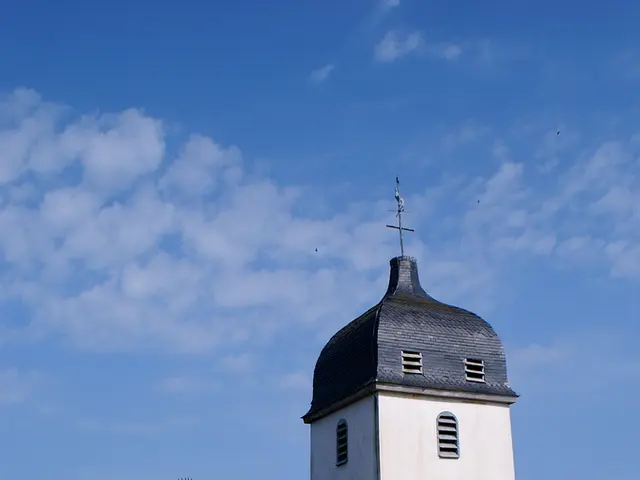Unique and Awe-Inspiring Temples of Japan: A Captivating Exploration of Ten Stunning Structures
Visit the top 10 spectacular Japanese temples that offer a unique blend of history, culture, and spirituality. Whether you're seeking the tranquility of Mt. Fuji's surroundings, the allure of the Golden Pavilion in Kyoto, or the mysterious atmosphere of the Aka Ninja Temple in Kanazawa, there's something for everyone.
1. Gotoke-Ji (Tokyo)
Gotokuji Temple, built in 1480, is a Soto Sect temple that's known for being the origin of the Beckoning Cat, Manekineko. The temple is brimming with these iconic lucky statues, perfectly positioned with their right hands raised in invitation. Enjoy the historical ambiance amidst the good fortune of Manekineko in this old Japanese atmosphere. Take a stroll through the quaint neighborhood, truly appreciating its charm.
Official Website: Gotokuji Temple
2. Yamadera Temple (Yamagata Prefecture)
Yamadera, also known as Risshyku-ji, is a temple famous for the inspiring haiku by Matsuo Basho, who wrote of its tranquility and beautiful scenery. Sitting atop Mount Yamadera, the approach to this temple involves a steep climb of 1,015 steps for a truly austere and spiritual journey. The temple's beauty is especially stunning in the fall, when it's covered in vibrant autumn leaves.
Official Website: Yamadera (Risshyku-ji) (Only in Japanese)
3. Okuno-in Temple (Koyasan, Wakayama Prefecture)
Okuno-in Temple is the sacred site where Kobo Daishi, the founder of Shingon Buddhism, was enshrined. The temple's approach is lined with more than 200,000 tombstones, including those of historical figures like Takeda Shingen and Oda Nobunaga. Stepping amidst the towering cedar trees, you'll find yourself on an adventure that invites you to experience the mystical atmosphere of this temple surrounded by mountains.
4. Myouryu-Ji (Aka Ninja Temple, Ishikawa Prefecture)
Myouryu-ji, or the "Red Dragon Temple," is a hidden wonder with tricks and secrets hidden throughout its temple. It has a maze-like structure with hidden staircases, pit money boxes, and even a well said to have led to Kanazawa Castle—the perfect place for an exhilarating adventure reminiscent of ninjas.
5. Ryoan-Ji (Kyoto)
Ryoan-Ji, established in 1450 during the Muromachi shogunate by Hosokawa Katsumoto, is one of Japan's most renowned temples. Even Queen Elizabeth II praised its garden, which highlights the spirit of "wabi-sabi" unique to Zen temples, featuring an extraordinary arrangement of stones creating a serene atmosphere.
Official Website: Ryoanji (Only in Japanese)
6. Hokoku-Ji (Kamakura, Kanagawa Prefecture)
Kamakura, dotted with historical temples, is known for its bamboo grove at Hokoku-Ji. With approximately 2,000 bamboo trees, this grove offers a serene atmosphere filled with negative ions, perfect for unwinding with a cup of matcha tea.
Official Website: Hokokuji Temple
7. Todai-Ji (Nara Prefecture)
Todaiji Temple, founded in the Nara period, is home to the massive Great Buddha Hall, one of the largest wooden structures globally. The temple houses the Daibutsu, a statue of Buddha representing happiness. Don't miss the Todaiji Museum Shop for a variety of goods symbolizing the history and beauty of the Great Buddha!
Official Website: Todaiji Temple
8. Sanjusangendo Temple (Kyoto)
Sanjusangendo consists of 33 pillar halls numbering more than 1,000 exquisitely crafted, life-size wooden statues of the Thousand-Armed Kannon. Each statue captivates visitors with the profound beauty of Japanese Buddhist art. With stunning architectural structure and historical value, Sanjusangendo is an awe-inspiring cultural experience.
Official Website: Sanjusangendo Temple
9. Kongobu-Ji (Mount Koya, Wakayama Prefecture)
Mount Koya, renowned as a sacred site of Shingon esoteric Buddhism, is home to Kongobu-ji—the head temple of the Koyasan Shingon sect. The Yanagi-no-Ma, or Willow Room, is of great historical importance and is said to be where Hidetsugu Toyotomi, a key figure during the Sengoku period, took his life.
Official Website: Kongobuji Temple
10. Byodoin Temple (Uji, Kyoto Prefecture)
Byodoin Temple is a must-see in Uji, symbolizing the prosperity of the Fujiwara family during the Heian period. The Phoenix Hall, a UNESCO World Heritage site, fosters the rich history and aristocratic culture of the Heian period while offering a moment of tranquility amidst nature. The scenery changes with the passing of seasons, creating a harmonious blend of history and beauty like no other.
Official Website: Byodoin Temple
Experience the timeless allure of these temples and delve into the fascinating world of Japanese history, art, and spirituality. Marvel at each temple's unique charm, and let your journey deepen your connection with this historic land. Join our tours to make the most out of your exploration of Japan!
Explore the charms of Japan's rich history and culture by visiting its awe-inspiring temples. From the enchanting Gotokuji Temple in Tokyo, known for its lucky Manekineko statues, to the mystical Okuno-in Temple in Koyasan with its towering cedar trees and historical figures' tombstones. Don't forget the Aka Ninja Temple, Myouryu-ji, in Ishikawa Prefecture, where you can experience ninja-like tricks and secrets hidden throughout its maze-like structure.
For nature lovers, Hokoku-Ji in Kamakura offers a serene bamboo grove, while Todai-Ji in Nara houses the massive Great Buddha Hall, one of the largest wooden structures globally. Sanjusangendo Temple in Kyoto showcases over 1,000 exquisite wooden statues of the Thousand-Armed Kannon, each captivating visitors with the profound beauty of Japanese Buddhist art.
The tranquility of Mt. Fuji's surroundings, the inspiring haiku inspired views from Yamadera Temple in Yamagata Prefecture, and the magnificent Phoenix Hall at Byodoin Temple in Uji are must-sees. It's worth noting that the wildlife lover in you will be delighted at Hokoku-Ji, as it houses approximately 2,000 bamboo trees, offering a serene atmosphere filled with negative ions, perfect for unwinding with a cup of matcha tea.
Moreover, Religion and culture enthusiasts will appreciate Kongobu-ji, the head temple of the Koyasan Shingon sect on Mt. Koya, known for the Yanagi-no-Ma or Willow Room, of great historical importance. Lastly, visit the famous Byodoin Temple, a UNESCO World Heritage site, symbolizing the prosperity of the Fujiwara family during the Heian period and fostering the rich history and aristocratic culture of the Heian period while offering a moment of tranquility amidst nature.
To fully immerse yourself in the unique experiences offered by these temples, consider joining our cultural tours. Moreover, don't forget to purchase souvenirs representing Japanese history, food, lifestyle, home-and-garden, and tradition, from the temple's souvenir shops, as a memento of your unforgettable journey.








